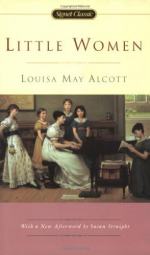|
This section contains 692 words (approx. 2 pages at 400 words per page) |

|
Little Women falls inside and outside a "family novel" tradition traceable to Jane Austen in England, whose Pride and Prejudice for adults, published in 1813, was marked by depictions of manners and sisterly bonds. Novels written by and for women became popular in both England and America in the nineteenth century. In the decades just before Little Women appeared, Susan Warner in the United States and Charlotte Yonge in England wrote in the nineteenth century's most popular fictional form, the sentimental domestic novel. These works, read by both adults and young people, presented morally good characters as role models.
Jo March is seen in Chapter 11 reading The Wide, Wide World, published in 1850 by Warner writing under the pseudonym of Elizabeth Weatherell.
Warner's novel does not portray a happy family unit, but its heroine Ellen Montgomery, age ten at the outset, meets and conquers tribulations to achieve moral...
|
This section contains 692 words (approx. 2 pages at 400 words per page) |

|




